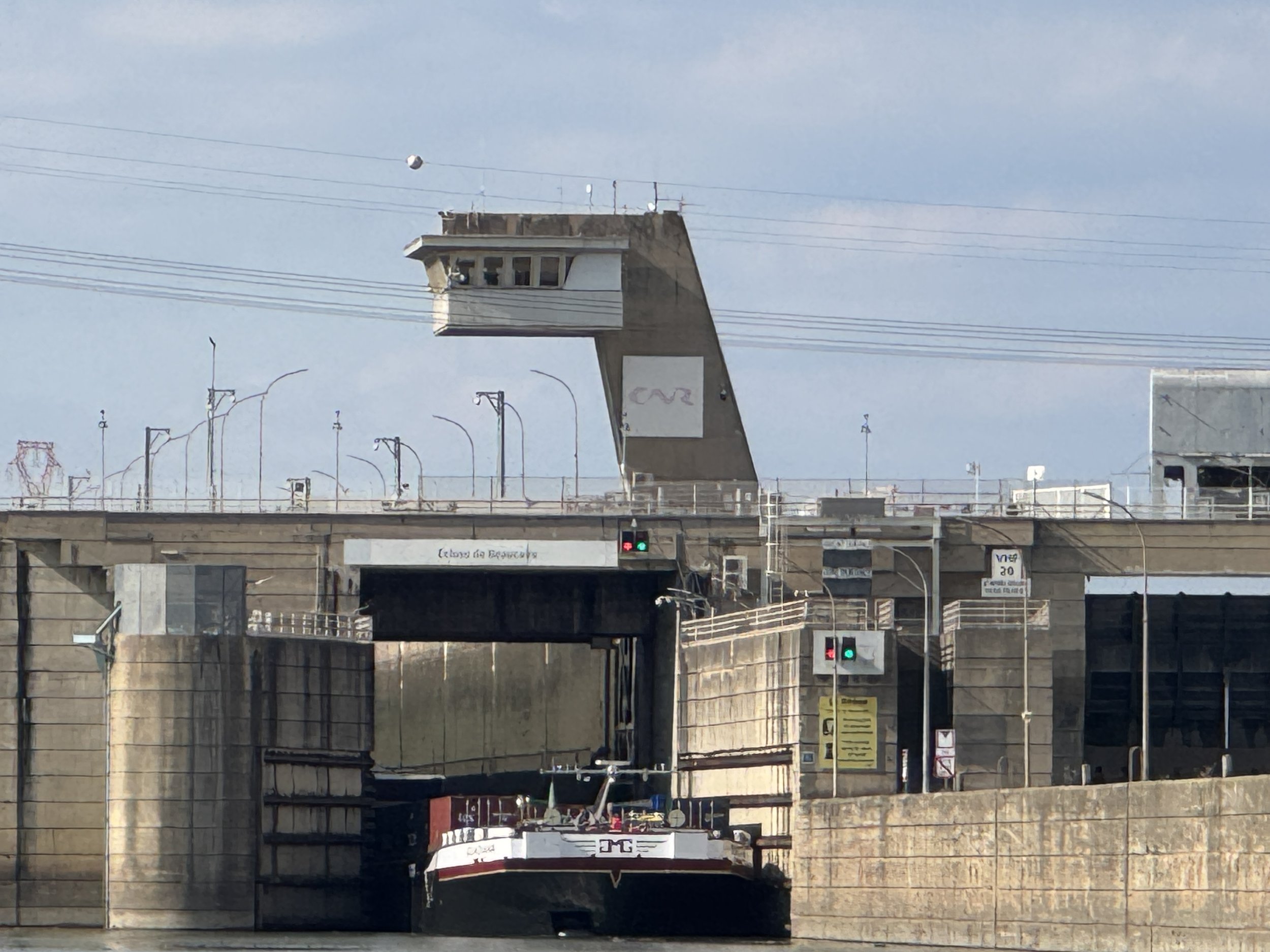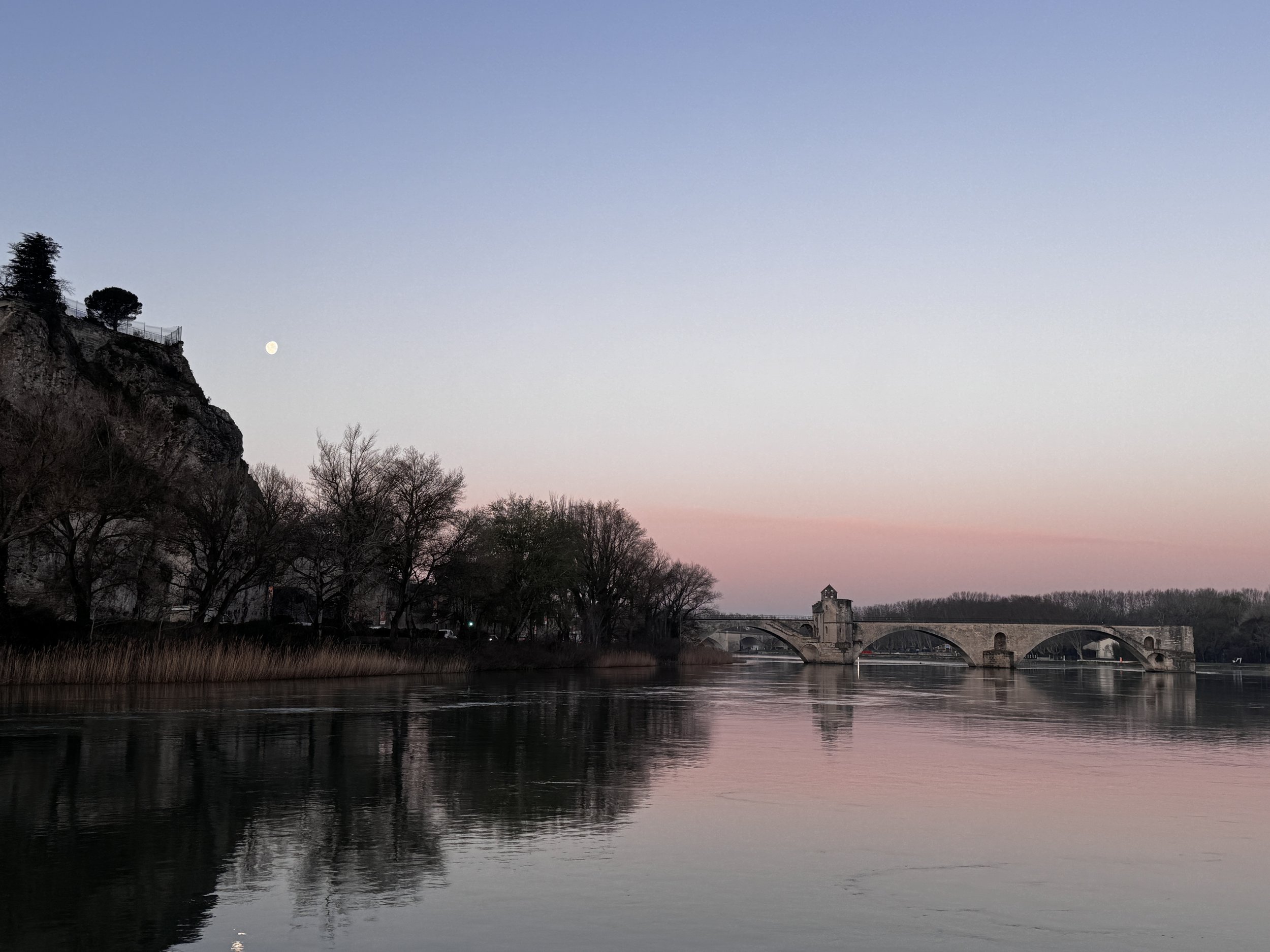The Lower Rhône
The week on our private dock in Saint-Gilles turned into 11 days. Heavy rains swelled the rivers and high currents closed many of the docks and pontoons along our route. The day the lock opened we learned that the spot where we had planned to spend our first night was now closed - we decided to stay put where we were. The extra few days gave us a chance to take a long hike through the countryside, forests and farmland and we viewed from the bridge above what would be our first lock.












We discovered we had a neighbor as well. A boat similar in size to Meraki had tied to the bank around the bend downstream of us. Living aboard was a German couple who now call Finland their home - though they’ve lived aboard their boat now for 25 years! They have crossed the Atlantic four times, visited Svalbard twice and spent one winter in Greenland where they had to chainsaw the ice around their boat each morning to remain floating! They made a video chronicling one of their North Atlantic crossings and we are eager to watch but unfortunately don’t have a DVD player aboard. They are salt-of-the-earth adventurers, living off the land (and sea) as much as possible…they remind me of many Alaskans with their gutsy, somewhat audacious, hardiness and I thoroughly enjoyed hearing of their exploits.
Low fog rolled across the canal as the sun rose on departure day. We checked the river currents and closures along the canals in anticipation. I brushed up on conversational French with lock-keepers and prepped the boat for moving on.
We arrived at our the first small lock in just a few minutes and the light was green - the lock was ready for us. We had observed the lock from the bridge above while on our hike, the rise was not much (at times only six inches) and I knew what to expect. Or so I thought. We motored in and I looped the two lines around the small white bollard recessed in the wall. The lock closed and we rose as the water came slowly in. What I hadn’t planned on was what to do when the bollard I was holding onto became too low in the wall to hold the boat. We began to rise above the bollard (nearly 2 meters) as I tried to hold on down by my feet. I needed to throw the lines around a post up above on the ground at the top of the lock, but as we were pinned next to the wall I had no room to throw the lines. I tried several times unsuccessfully. I yelled to Tom to come help and he tried several times as well, eventually looping one of the two ropes around the bollard at the top. By that time, fortunately, we had risen all the way and we simply needed to wait for the gates to open so we could exit. I hadn’t been overly worried when we began, but now I was super stressed. That had not gone well and I felt completely ill prepared.







The Canal du Rhône à Sète became the Petit Rhône River and as we continued on we discussed what had gone wrong. I practiced throwing lines a new way on the bow of the boat as we cruised. Not only did I need to learn to throw over my head with no space in front of me, but I also needed to practice throwing our new, longer, lighter lines which behaved quite differently from the ones I’d become accustomed to.
We arrived at our planned stop on the Petit Rhône which proved impossible - due to all the rain the pontoon we’d hoped to tie up to was completely submerged. It’s a wonder we even noticed it! We would have to continue onto the Rhône River today and find a place further ahead. We were both nervous about the swift currents on the big river. I was expecting turbulent waters at the confluence but the two rivers just gradually flowed into each other. The current did increase a bit as we got out into the flow heading upstream so we throttled up to stay abreast of it - which we calculated to be about 3-4knots.









Further on we realized we would pass another lock before we could stop for the day and this one was quite a bit larger. The rise here would be 11.6 meters (38 feet). As we approached, I radioed the lock keeper. I had spoken in French but could not understand his response, eventually switching to English - but I still did not understand. We then noticed that there was a barge approaching from downstream and I realized that we had been told to wait. We held our position as best we could in the middle of the river to let the ship pass to our left. The barge was HUGE - 110 meters long (361 feet). As it entered the lock we also noticed on our navigation screen that there was another boat 5 km upstream heading down towards the lock as well. Commercial traffic has priority on all waterways in France so we knew we would have to wait for this one too. We motored over to the waiting pontoon just outside the entrance and tied up. Water thundered down over the spillway above the dam just ahead and neither of us felt secure on the dock as Meraki was pushed side to side in the heavy flow. Tom checked and rechecked our mooring lines while I rearranged all the other lines on the boat, switching the lock lines to the older, heavy ones that I was used to managing. I put a line on every cleat in case we needed to tie up on the port side for some reason. I then flaked the lines I planned to use, feeding the bitter ends back to the cleats and then doubling back so that I could grab them quickly from mid-ship. Tom and I discussed what each of us would do. It took an hour and a half for the second vessel to emerge and continue downstream. All that waiting gave us both plenty of time to fret about what was to come. We were very nervous and anxious when it was finally our turn.
We entered the lock, idling slowly forward and up to the bollard in the wall. These were floating bollards which meant they would rise along with us and there would be no need to move the lines up as we went. HOORAY! I looped both lines over the bollard and handed one to Tom, taking mine aft to the stern cleat. The gates closed behind us, the water rose, and we held fast. It went super smoothly! The fenders and lines were perfectly placed, we made note of small tweaks we could make to relax things a bit but overall we were quite pleased. It surprisingly only took about 15 minutes to fill the lock, we waited for the green light and exited. I thanked the lock-keeper who cheerfully wished us a pleasant day and a safe journey - in perfect English!









Now to find a place to stop. I was realizing why people tend to wait until April to travel the Rhône - lots of places are still closed for the winter in March. I called for a berth for a few nights in Avignon but got a recording that I didn’t understand. I listened four times trying to glean it’s meaning; were they closed for lunch, opening next month, closed permanently? I eventually gave up. It was about an hour and a half before sunset and pleasure boats are not permitted to move after dark. We needed a place to stop and soon. We throttled up to 2300 RPM which gave us about 6knots of speed against the current.
The only other possible overnight dock before Avignon was a small pontoon in the town of Aramon - but as we approached it became clear that it was completely full with over-wintered boats. Continuing on we arrived in Avignon just before sunset. Thankfully the town quay was fairly empty and we pulled up alongside, tied up and killed the engines, feeling greatly relieved. We were both mentally and physically exhausted. Worry and rumination is mentally draining, and without my awareness, the heightened anxiety had caused me to tense all my muscles. When I finally could relax - my body was completely fatigued. I hadn’t exercised all day and yet I felt totally wrung out.




We sat unmoving in the silence for a bit, then rallied and made dinner, and after a much needed sleep we awoke to a very cold but clear and sunny morning. It had been 12 days since we’d filled our water tank (we were not using our watermaker on the rivers) and although we still had almost a quarter of a tank left I was eager to fill up. The spigot on the quay was working but it was a strange size and had a broken fitting stuck inside. Tom spent the better part of an hour with his various pipe fittings building something that would connect to our hose.
We filled the tank, made a quick stop at a laundromat and then went exploring. Avignon sits on the banks of the Rhône River encircled by medieval walls. In the 14th century it was the seat of power for the Catholic church.
We meandered along the twisting, cobblestone streets, gazing in the shops, until we found a small corner café where we sat outside and had a bite of lunch followed by pastry and ‘noisette café - ‘noisette’ means hazelnut which refers to the color of the coffee not the flavor.
Next we visited Le Palais des Papes - the Papal Palace, which is the world’s largest gothic monument, the site of the reign of popes in the 14th century (outside of the Vatican). We toured the twenty-five rooms inside the palace which depict private apartments, huge dining halls, kitchens, frescoes and architectural grandeur. We wondered outside into the Papal Gardens which were just coming to life. I could imagine what they would look like in full bloom in another month or two.























We strolled on towards the famous Pont Saint-Bénézet, the 12th century bridge which is easily recognizable as it ends half-way across the river; the flooding of the Rhône over time disintegrated the other half.
In the 15th century, Europe entered a mini ice age which significantly changed the hydrological conditions of the Rhône catchment area. Additionally the King of France at the time commissioned work on the arm of the river which altered the current. The bridge could not withstand the changes and the arches were regularly swept away. It was no longer used after the 17th century, until in the 19th century restoration commenced on the remaining four arches standing today.





We returned to Meraki after a lovely day, cooked dinner and spent the night preparing to venture further up the Rhône in the morning.
Note: photo captions will not appear if viewing on a cell phone.







